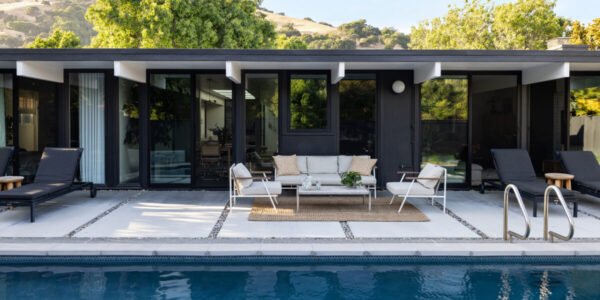
How to Boat Camp the Russian River
No more excuses—it’s time to check Russian River canoe camping off your bucket list

Lined with lush stands of Coast Redwoods and Sonoma County’s seemingly ubiquitous vineyards, the lazy backwater of Northern California’s Russian River is a must-visit destination for any nature lover. Follow the watercourse from the inland valleys all the way out to Jenner, where the river spills into the Pacific, for a crash course in wine country’s allure. No canoe? Don’t fret. Myriad outfitters and campgrounds mean there are options for every adventurer.
When to Go
The dog days of summer are a safe bet. However, early autumn can be equally enjoyable: The weather is still pleasant, but a fraction of the people will be on the water come September and early October. And because seasonal dams erected near Johnson’s Beach and Vacation Beach usually come down after Labor Day, fall paddlers don’t have to portage boats, either. (It’s wise to bring a lightweight, portable kayak dolly in the summer.) During the winter months, storms can swell the river, creating strong currents and hidden obstacles. Suppliers may not open shop again until mid-May or later, so June through September is the ideal window for planning trips in advance.
Who to Go With
Outfitters can set you up with anything from kayaks to tour-ready stand-up paddleboards, although a classic canoe is the best choice for those toting large coolers. Forestville stalwart Burke’s Canoe Trips have it dialed in. They’ll turn you loose with a canoe (or kayak) plus paddles and life jackets, and shuttle you back to your vehicle in a big white school bus afterward. For a more structured experience, hire guides from Healdsburg’s Russian River Adventures or River’s Edge Kayak & Canoe Trips on the upper section of the river. Keen on getting some river time on a stand-up paddleboard? SUP Odyssey east of Guerneville offers hourly and multi-day rentals.
What to Bring
Although it’s feasible to grab last-minute items in Forestville or Guerneville (Big Bottom Market is a favorite for day-one lunch), stock up on food and camping gear before you exit U.S. 101. In addition to the essentials—sunscreen, dry clothes, sunglasses, and plenty of food and water—be sure to bring swimming gear. You’ll find innumerable spots for a quick dip, from naturally formed jumping rocks to rope swings fashioned by the locals. Bring bungee cords to secure everything should your boat tip as you clamber out. Water shoes and dry bags will also make your trip more enjoyable, as will binoculars.
What You’ll See
Great blue herons and hawks are among the most common birds in the area, and Western pond turtles are frequently glimpsed too (identify them by their mottled heads and dark-patterned shells as they sun themselves on fallen trees). Keep your eyes peeled for stealthier species, such as bobcats, mountain lions, and even elusive red foxes. And don’t forget to look down—in the water, endangered Coho salmon swim alongside countless aquatic species, including rare river otters.
Where to Go
Over 100 miles long, the Russian River is most digestible if you focus on the lower section—especially for weekend warriors. While you can set out anywhere with boat access, make sure to have a plan in place as cell service on the North Coast is spotty at best. If you have two vehicles able to haul boats, meet in the town of Jenner and set up a two-car relay system. Be sure to hit up the Jenner Visitors Center just off Highway 1 (707/865-9757) to brush up on your local knowledge before embarking.
Leave another vehicle (or get dropped off) in Guerneville, where you’ll have your pick of Johnson’s Beach, Guerneville River Park, or the less formal Vacation Beach, about two miles south of town, for unloading. Those on a prolonged schedule can start upstream in Forestville—Wohler Bridge and Steelhead Beach Regional Park both have suitable launches—or even Healdsburg Veterans Memorial Beach if you’re feeling ambitious. However, you may have to portage boats near Johnson’s Beach or Vacation Beach.
Meandering downstream, you’ll pass an abundance of private docks. Somewhere around 90 percent of the Russian River watershed is privately owned, so respect private property signs as you get a sneak peek of this wonderful zone. And don’t be surprised if a passing paddler gives you a friendly blast of water—it’s a river tradition! Refuel on the go as the leisurely summer current conveys your boat, or sidle up to any old sandbar at lunchtime.
Where to Roll out Your Sleeping Bag
Camping is another story. All overnighters must sleep in designated sites, but the proliferation of campgrounds along the waterfront means it’s no problem. We recommend camping at River Bend Resort in Forestville for the first night of a multi-day journey. You can even sleep in a cabin or tricked-out bus refurbished with reclaimed wood. Prefer to rough it? Ditch the boats at Schoolhouse Canyon Campground’s private beach and cross River Road to their tent sites (first come, first served, or 2-night minimum for reservations).
Downstream in Duncans Mills, Casini Ranch Family Campground (from $51, 2-night minimum May-Sept.; casiniranch.com) has several beachfront sites you can practically paddle up to. Situated right on the water on a huge horseshoe bend, it’s a good hitching post for a night or two if you have a yen for amenities like a general store, guided hikes, and weekly bonfires on the beach during high season.
For a more natural experience (read: no plumbing), continue on to picturesque Willow Creek Environmental Campground (first come, first served). It’s not much farther to the boat ramp by Jenner Visitors Center, which is a good thing because strong winds often pick up late in the day and you’ll want to make it back to the estuary early. Remember, you’ll need time to retrieve your vehicle and refuel at one of the Bodega coast’s numerous chowder shacks on the drive home.
Plan on 4-5 hours of actual paddling each day (or up to 7 hours if traveling by canoe), but allow plenty of time for distractions. That’s why you’re here, isn’t it?
